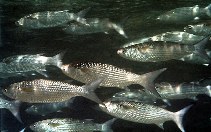| Family: |
Mugilidae (Mullets) |
| Max. size: |
60 cm TL (male/unsexed) |
| Environment: |
reef-associated; brackish; marine; depth range 0 - 20 m, non-migratory |
| Distribution: |
Indo-Pacific: Red Sea and East Africa to the Line and Tuamoto islands, north to southern Japan, south to Lord Howe Island. |
| Diagnosis: |
Dorsal spines (total): 4-5; Dorsal soft rays (total): 9-10; Anal spines: 3-3; Anal soft rays: 8-10. Silvery in color, greenish olive above; pectoral fins pale yellow with purplish axillary spot, other fins grey (Ref. 4393).
Description: Characterized by having circumpeduncular scales 19-20, cycloid scales or weakly ctenoid; snout shorter than eye diameter, 5.2-9.5 in head length; very thick upper lip with 1-10 rows of papillae (in fish larger than about 7 cm TL); thin lower lip, anterior margin turned out and downwards; inner part of lower lip with 1-2 rows of papillae; narrow rim around eye formed by adipose eyelid; preorbital concave on anteroventral edge (Ref. 90102). |
| Biology: |
Found in coastal waters, over sandy or muddy areas of lagoons, reef flats and tide pools; enters harbors (Ref. 9812). Schooling species, swim at various depths along reefs, to about 20 meters but usually much shallower. Feed on detritus containing algae and microscopic animals, by scooping up the upper layer of sand or mud and filtering through the gills (Ref. 48637). Omnivorous (Ref. 6113). Form large schools before spawning, at the beginning of the ebb tide (in June), over shallow, open areas of the lagoon slope (Ref. 9812). Oviparous, eggs are pelagic and non-adhesive (Ref. 205). Spawning occurs in large aggregations after dark. Marketed fresh (Ref. 9812). Minimum depth reported taken from Ref. 30874. |
| IUCN Red List Status: |
Least Concern (LC); Date assessed: 02 July 2016 Ref. (130435)
|
| Threat to humans: |
reports of ciguatera poisoning |
Source and more info: www.fishbase.org. For personal, classroom, and other internal use only. Not for publication.
